Is Overgrazing Really Influencing Soil Erosion?
Abstract
1. Introduction
2. Materials and Methods
2.1. Study Area and Archaeological Background
2.2. Methodology
2.2.1. FR Method
2.2.2. IV Method
2.3. Combining Spatial Data
Gully Inventory Map and Conditioning Factors
3. Results and Discussion
3.1. GSI Using FR
3.2. GSI Using IV
3.3. Validation and Comparison of the GSI Maps
3.4. Cultural Heritage Affected by Gully Erosion
4. Discussion
5. Conclusions
Funding
Acknowledgments
Conflicts of Interest
References
- Boardman, J.; Vandaele, K. Soil erosion, muddy floods and the need for institutional memory. Area 2010, 42, 502–513. [Google Scholar] [CrossRef]
- Xiong, M.; Sun, R.; Chen, L. Effects of soil conservation techniques on water erosion control: A global analysis. Sci. Total Environ. 2018, 645, 753–760. [Google Scholar] [CrossRef] [PubMed]
- Borelli, P.; Panagos, P.; Ballabio, C.; Lugato, E.; Weynants, M.; Montanarella, L. Towards a Pan-European assessment of land susceptibility to wind erosion. Land Degrad. Dev. 2016, 27, 1093–1105. [Google Scholar] [CrossRef]
- Poesen, J.W.; Verstraeten, G.; Soenens, R.; Seynaeve, L. Soil losses due to harvesting of chicory roots and sugar beet: An underrated geomorphic process? Catena 2001, 43, 35–47. [Google Scholar] [CrossRef]
- Karydas, C.G.; Panagos, P. The G2 erosion model: An algorithm for month-time step assessments. Environ. Res. 2018, 161, 256–267. [Google Scholar] [CrossRef] [PubMed]
- Frankl, A.; Prêtre, V.; Nyssen, J.; Salvador, P.-G. The success of recent land management efforts to reduce soil erosion in northern France. Geomorphology 2018, 303, 84–93. [Google Scholar] [CrossRef]
- Vanmaercke, M.; Poesen, J.; Van Mele, B.; Demuzere, M.; Bruynseels, A.; Golosov, V.; Rodrigues Bezerra, J.F.; Bolysov, S.; Dvinskih, A.; Frankl, A.; et al. How fast do gully headcuts retreat? Earth-Sci. Rev. 2016, 154, 336–355. [Google Scholar] [CrossRef]
- Zabihi, M.; Mirchooli, F.; Motevallli, A.; Darvishan, A.K.; Pourghasemi, H.R.; Zakeri, M.A.; Sadighi, F. Spatial modelling of gully erosion in Mazandaran Province, northern Iran. Catena 2018, 161, 1–13. [Google Scholar] [CrossRef]
- Poesen, J.; Nachtergaele, J.; Verstraeten, G.; Valentin, C. Gully erosion and environmental change: Importance and research needs. Catena 2003, 50, 91–133. [Google Scholar] [CrossRef]
- Valentin, C.; Poesen, J.; Li, I. Gully erosion: Impacts, factors and control. Catena 2005, 63, 132–153. [Google Scholar] [CrossRef]
- Poesen, J. Soil erosion in the Anthropocene: Research needs. Earth Surf. Proc. Landf. 2018, 43, 64–84. [Google Scholar] [CrossRef]
- Adejini, A.; Jeje, L.K.; Ibitoye, M.O. Urban development and informal drainage patterns: Gully dynamics in Southwestern Nigeria. Appl. Geogr. 2013, 40, 90–102. [Google Scholar] [CrossRef]
- Chaplot, V. Impact of terrain attributes, parent material and soil types on gully erosion. Geomorphology 2013, 186, 1–11. [Google Scholar] [CrossRef]
- Goodwin, N.R.; Armston, J.; Stiller, I.; Muir, J. Assessing the repeatability of terrestrial laser scanning for monitoring gully topography: A case study from Aratula, Queensland, Australia. Geomorphology 2016, 262, 24–36. [Google Scholar] [CrossRef]
- Mukai, S. Gully erosion rates and analysis of determining factors: A case study from the semi-arid main Ethiopian Rift Valley. Land Degrad. Dev. 2016, 28, 602–615. [Google Scholar] [CrossRef]
- Zakerinejad, R.; Maerker, M. An integrated assessment of soil erosion dynamics with special emphasis on gully erosion in the Mazayjan basin, southwestern Iran. Nat. Hazards 2015, 79, 25–50. [Google Scholar] [CrossRef]
- Archibold, O.W.; Lévesque, L.M.J.; de Boer, D.H.; Aitken, A.E.; Delanoy, L. Gully retreat in a semi-urban catchment in Saskatoon, Saskatchewan. Appl. Geogr. 2003, 23, 261–279. [Google Scholar] [CrossRef]
- Ioniță, I.; Niacșu, L.; Petrovici, G.; Blebea-Apostu, A.M. Gully development in eastern Romania: A case study from Falciu Hills. Nat. Hazards 2015, 79, 113–138. [Google Scholar] [CrossRef]
- Nicu, I.C. Natural risk assessment and mitigation of cultural heritage sites in North-eastern Romania (Valea Oii river basin). Area 2018. [Google Scholar] [CrossRef]
- Hayas, A.; Poesen, J.; Vanwalleghem, T. Rainfall and vegetation effects on temporal variation of topographic thresholds for gully initiation in Mediterranean cropland and olive groves. Land Degrad. Dev. 2017, 28, 2540–2552. [Google Scholar] [CrossRef]
- Zgłobicki, W.; Poesen, J.; Cohen, M.; Del Monte, M.; García-Ruiz, J.M.; Ioniță, I.; Niacșu, L.; Machová, Z.; Martín-Duque, J.F.; Nadal-Romero, E.; et al. The potential of permanent gullies in Europe as geomorphosites. Geoheritage 2017. [Google Scholar] [CrossRef]
- Conforti, M.; Aucelli, P.P.C.; Robustelli, G.; Scarciglia, F. Geomorphology and GIS analysis for mapping gully erosion susceptibility in the Turbolo stream catchment (Northern Calabria, Italy). Nat. Hazards 2011, 56, 881–898. [Google Scholar] [CrossRef]
- Dewitte, O.; Daoudi, M.; Bosco, C.; Van Den Eeckhaut, M. Predicting the susceptibility to gully initiation in data-poor regions. Geomorphology 2015, 228, 101–115. [Google Scholar] [CrossRef]
- Conoscenti, C.; Agnesi, V.; Cama, M.; Caraballo-Arias, N.A.; Rotigliano, E. Assessment of gully erosion susceptibility using multivariate adaptive regression splines and accounting for terrain connectivity. Land Degrad. Dev. 2017. [Google Scholar] [CrossRef]
- Rahmati, O.; Haghizadeh, A.; Pourghasemi, H.R.; Noormohamadi, F. Gully erosion susceptibility mapping: The role of GIS-based bivariate statistical models and their comparison. Nat. Hazards 2016, 82, 1231–1258. [Google Scholar] [CrossRef]
- Stringer, L.C.; Scrieciu, S.S.; Reed, M.S. Biodiversity, land degradation, and climate change: Participatory planning in Romania. Appl. Geogr. 2009, 29, 77–90. [Google Scholar] [CrossRef]
- Rădoane, M.; Ichim, I.; Rădoane, N. Gully distribution and development in Moldavia, Romania. Catena 1995, 24, 127–146. [Google Scholar] [CrossRef]
- Ioniță, I. Gully development in the Moldavian Plateau of Romania. Catena 2006, 68, 133–140. [Google Scholar] [CrossRef]
- Mărgineanu, R.; Popa, N.; Olteanu, C. 137Cs use in sedimentation rate assessment in gullies and reservoirs in Romania. J. Environ. Prot. Ecol. 2007, 8, 197–203. [Google Scholar]
- Boengiu, S.; Vlăduț, A.; Marinescu, E. Conditions of gully development within piedmont areas with examples from the western part of the Getic Piedmont, Romania. J. Environ. Biol. 2012, 33, 407–415. [Google Scholar] [PubMed]
- Romanescu, G.; Nicu, I.C. Risk maps for gully erosion processes affecting archaeological sites in Moldavia, Romania. Z. Geomorphol. 2014, 58, 509–523. [Google Scholar] [CrossRef]
- Jurchescu, M.; Grecu, F. Modelling the occurrence of gullies at two spatial scales in the Olteț Drainage Basin (Romania). Nat. Hazards 2015, 79, 255–289. [Google Scholar] [CrossRef]
- Pederson, J.L.; Petersen, P.A.; Dierker, J.L. Gullying and erosion control at archaeological sites in Grand Canyon, Arizona. Earth Surf. Proc. Landf. 2006, 31, 507–525. [Google Scholar] [CrossRef]
- Tapete, D.; Cigna, F. InSAR data for geohazard assessment in UNESCO World Heritage sites: State-of-the-art and perspectives in the Copernicus era. Int. J. Appl. Earth Obs. 2017, 63, 24–32. [Google Scholar] [CrossRef]
- Nicu, I.C. Tracking natural and anthropic risks from historical maps as a tool for cultural heritage assessment: A case study. Environ. Earth Sci. 2017, 76, 330. [Google Scholar] [CrossRef]
- Nicu, I.C. Cultural heritage assessment and vulnerability using Analytic Hierarchy Process and Geographic Information Systems (Valea Oii catchment, North-eastern Romania). An approach to historical maps. Int. J. Disaster Risk Reduct. 2016, 20, 103–111. [Google Scholar] [CrossRef]
- Nicu, I.C. Frequency ratio and GIS-based evaluation of landslide susceptibility applied to cultural heritage assessment. J. Cult. Herit. 2017, 28, 172–176. [Google Scholar] [CrossRef]
- Nicu, I.C. Application of analytic hierarchy process, frequency ratio, and statistical index to landslide susceptibility: An approach to endangered cultural heritage. Environ. Earth Sci. 2018, 77, 79. [Google Scholar] [CrossRef]
- Nicu, I.C.; Asăndulesei, A. GIS-based evaluation of diagnostic areas in landslide susceptibility analysis of Bahluieț River Basin (Moldavian Plateau, NE Romania). Are Neolithic sites in danger? Geomorphology 2018, 314, 27–41. [Google Scholar] [CrossRef]
- Niculiță, M.; Mărgărint, M.C. Landslides and fortified settlements as valuable cultural geomorphosites and geoheritage sites in the Moldavian Plateau, North-eastern Romania. Geoheritage 2017. [Google Scholar] [CrossRef]
- Minea, I. Bazinul Hidrografic Bahlui. Studiu Hidrologic; Editura Universității Alexandru Ioan Cuza: Iași, Romania, 2013; p. 334. ISBN 978-973-703-754-1. [Google Scholar]
- Van Westen, C.J. Statistical Landslide Hazard Analysis. ILWIS 2.1 for Windows Application Guide; ITC Publication: Endschede, The Netherlands, 1997; pp. 73–84.
- Mararakanye, N.; Sumner, P.D. Gully erosion: A comparison of contributing factors in two catchments in South Africa. Geomorphology 2017, 288, 99–110. [Google Scholar] [CrossRef]
- Kheir, R.B.; Wilson, J.; Deng, Y. Use of terrain variables for mapping gully erosion susceptibility in Lebanon. Earth Surf. Proc. Landf. 2007, 32, 1770–1782. [Google Scholar] [CrossRef]
- Beven, K.J.; Kirkby, M.J. A physically based, variable contributing area model of basin hydrology. Hydrol. Sci. B 1979, 24, 43–69. [Google Scholar] [CrossRef]
- Jenness, J. Topographic Position Index (tpi_jen.avx) Extension for ArcView 3.x, version 1.2; Jenness Enterprises: Flagstaff, AZ, USA, 2006. [Google Scholar]
- Lucà, F.; Conforti, M.; Robustelli, G. Comparison of GIS-based gullying susceptibility using bivariate and multivariate statistics: Northern Calabria, South Italy. Geomorphology 2011, 134, 297–308. [Google Scholar] [CrossRef]
- Conoscenti, C.; Angileri, S.; Cappadonia, C.; Rotigliano, E.; Agnesi, V.; Märker, M. Gully erosion susceptibility assessment by means of GIS-based logistic regression: A case of Sicily (Italy). Geomorphology 2014, 204, 399–411. [Google Scholar] [CrossRef]
- Castillo, C.; Gómez, J.A. A century of gully erosion research: Urgency, complexity and study approaches. Earth-Sci. Rev. 2016, 160, 300–319. [Google Scholar] [CrossRef]
- Liu, S.; Wang, T. Aeolian processes and landscape change under human disturbances on the Sonid grassland of inner Mongolian Plateau, northern China. Environ. Earth Sci. 2014, 71, 2399–2407. [Google Scholar] [CrossRef]
- Wang, X.; Pedram, S.; Liu, T.; Gao, R.; Li, F.; Luo, Y. Estimated grass grazing removal rate in a semiarid Eurasian steppe watershed as influenced by climate. Water 2016, 8, 339. [Google Scholar] [CrossRef]
- Strunk, H. Soil degradation and overland flow as causes of gully erosion on mountain pastures and in forests. Catena 2003, 50, 185–198. [Google Scholar] [CrossRef]
- Riva, M.J.; Daliakopoulos, I.N.; Eckert, S.; Hodel, E. Assessment of land degradation in Mediterranean forests and grazing lands using a landscape unit approach and the normalized difference vegetation index. Appl. Geogr. 2017, 86, 8–21. [Google Scholar] [CrossRef]
- Shahbazi, K.; Salajagheh, A.; Jafari, M.; Ahmadi, H.; Nazarisamani, A.; Khosroshahi, M. Comparative Assessment of Gully Erosion and Sediment Yield in Different Rangelands and Agricultural Areas in Ghasr-e-Shirin, Kermanshah, Iran. J. Rangel. Sci. 2017, 7, 296–306. [Google Scholar]
- Boardman, J.; Parsons, A.J.; Holland, R.; Holmes, P.J.; Washington, R. Development of badlands and gullies in the Sneeuberg, Great Karoo, South Africa. Catena 2003, 50, 165–184. [Google Scholar] [CrossRef]
- Rowntree, K.; Duma, M.; Kakembo, V.; Thornes, J. Debunking the myth of overgrazing and soil erosion. Land Degrad. Dev. 2004, 15, 203–214. [Google Scholar] [CrossRef]
- Boardman, J. How old are the gullies (dongas) of the Sneeuberg uplands, Eastern Karoo, South Africa? Catena 2014, 113, 79–85. [Google Scholar] [CrossRef]
- Popa, L.-F. Tradiția și normele europene în activitatea păstorească din România. Geogr. Napoc. 2010, 1, 61–74. [Google Scholar]
- Nicu, I.C. Hydrogeomorphic Risk Analysis Affecting Chalcolithic Archaeological Sites from Valea Oii (Bahlui) Watershed, Northeastern Romania. In An Interdisciplinary Approach, 1st ed.; Springer: Cham, The Netherlands, 2016. [Google Scholar]
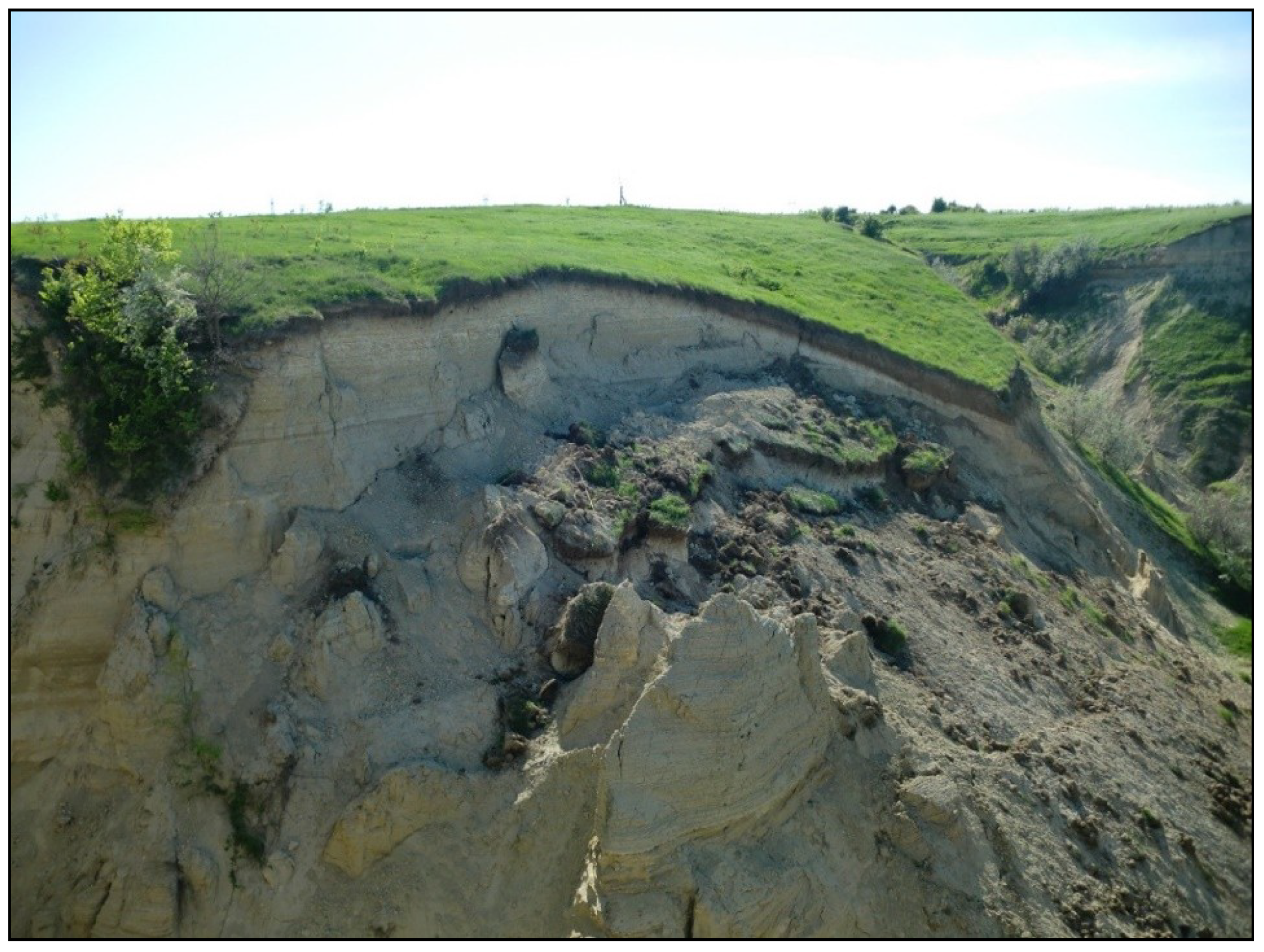
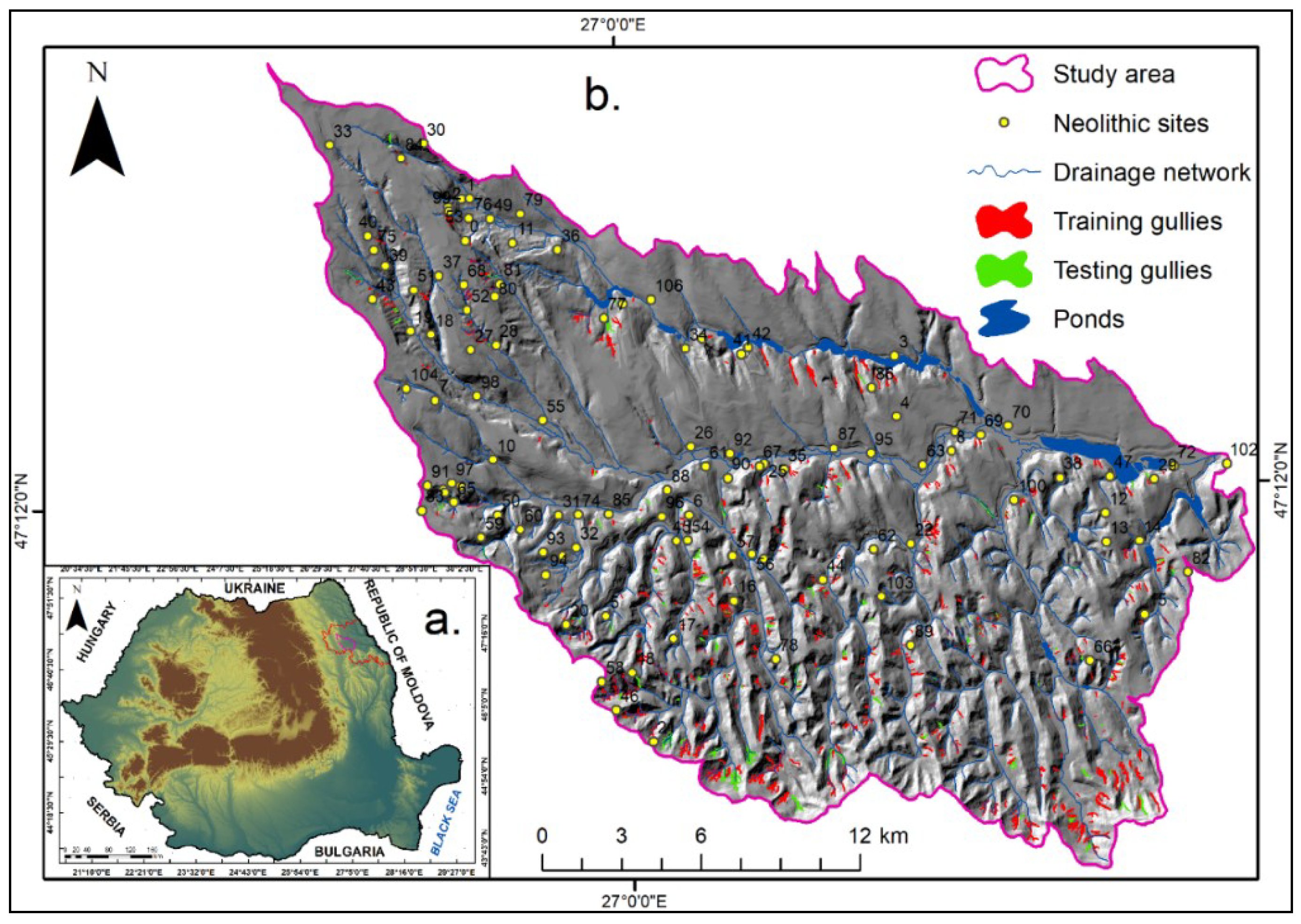
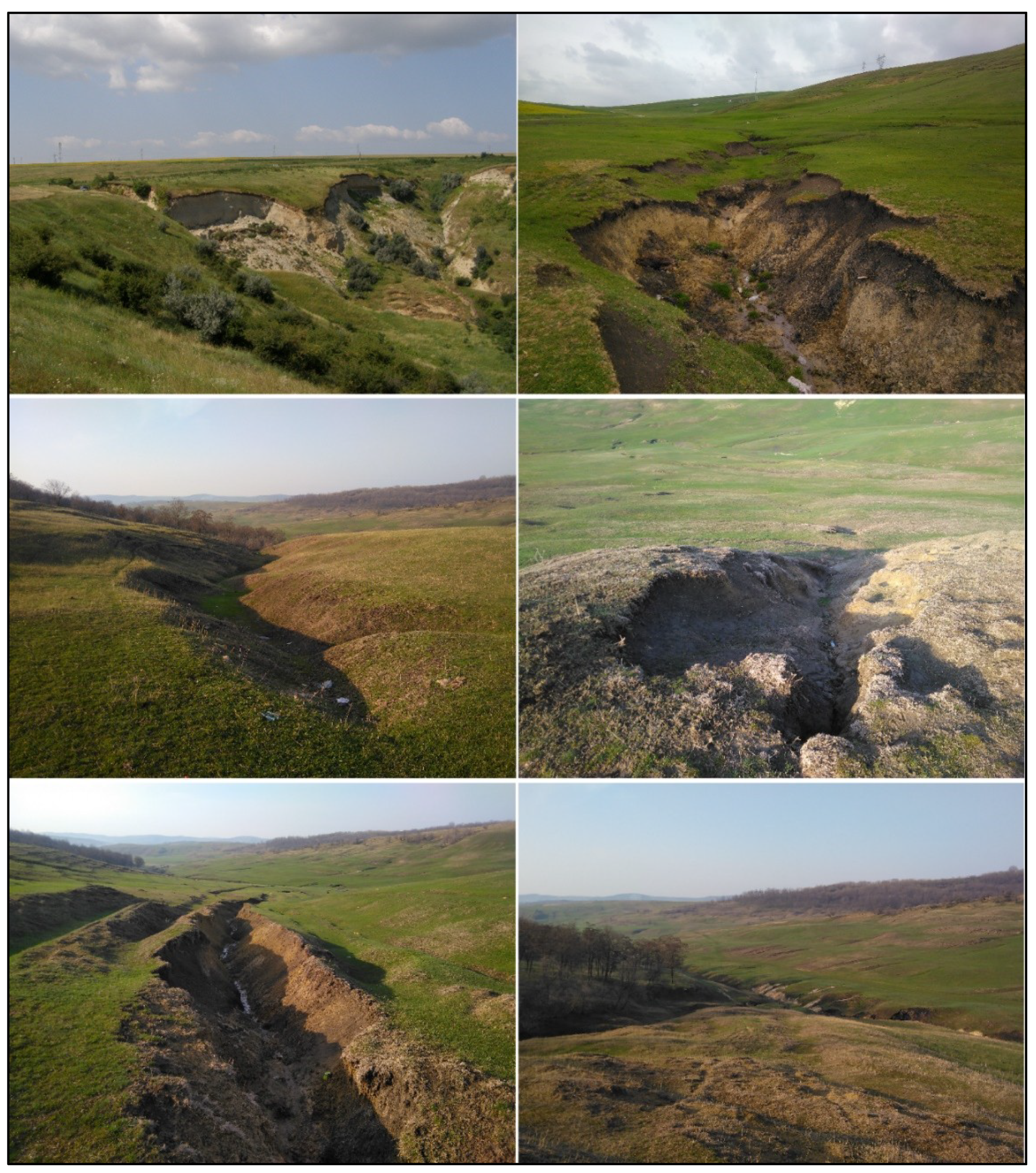
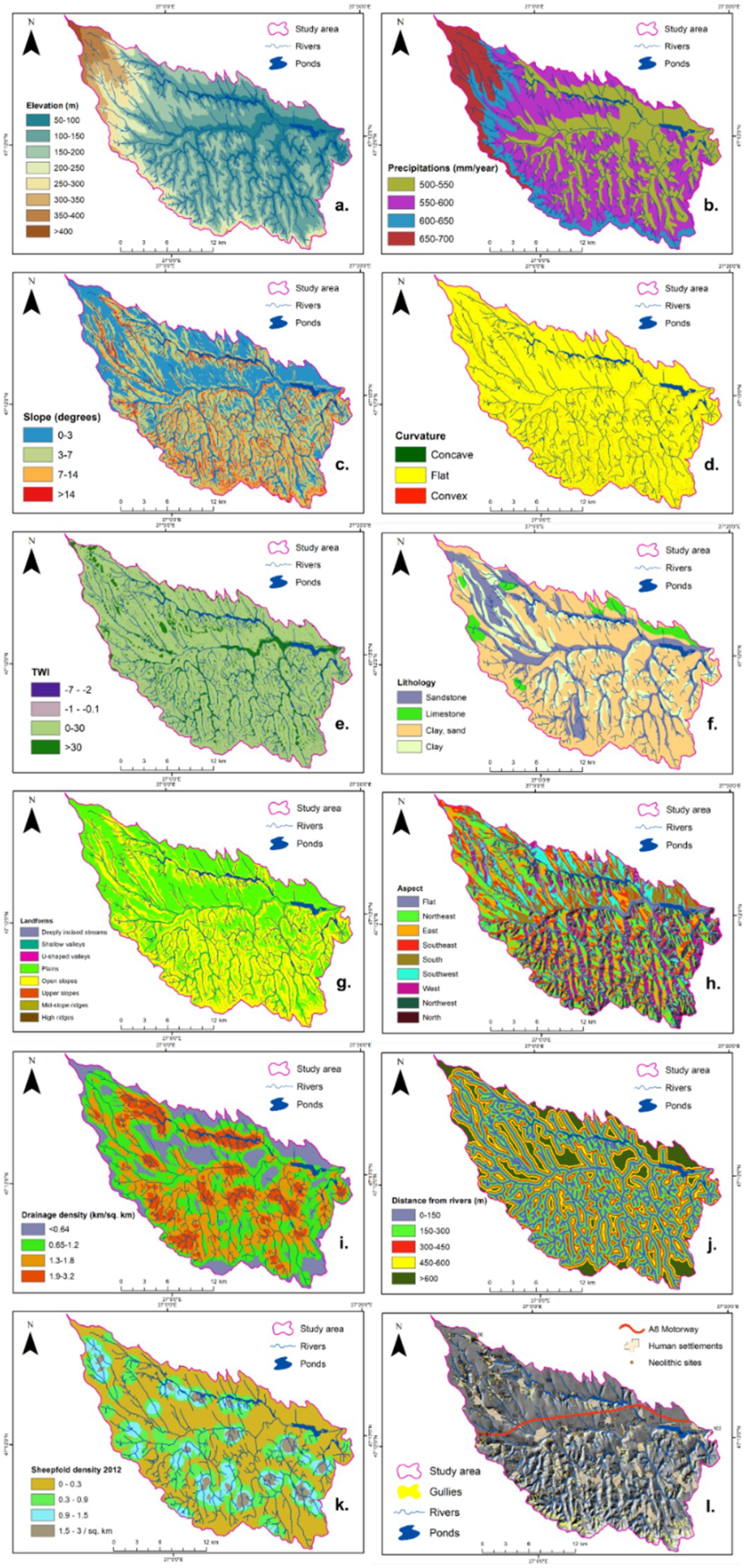
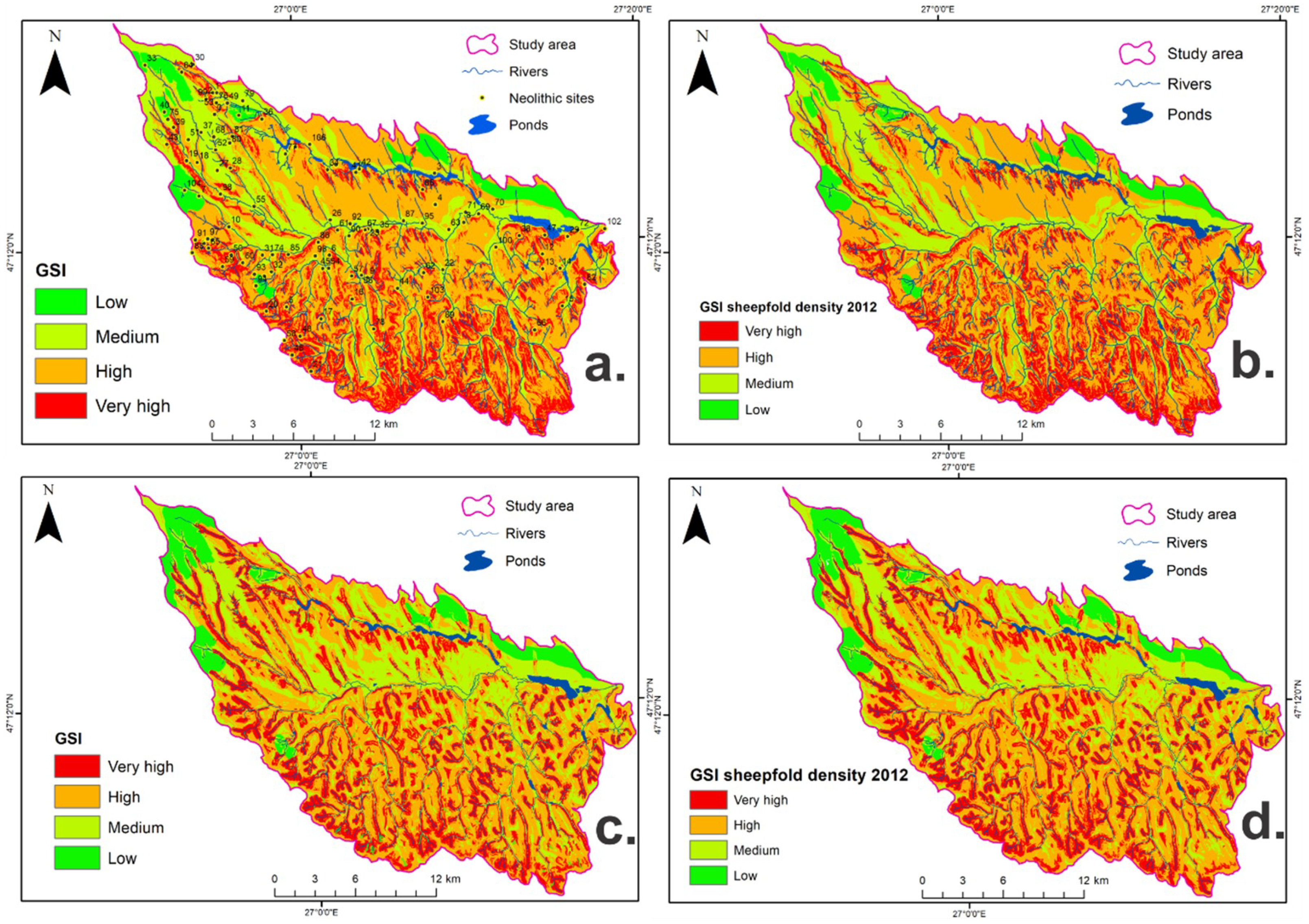
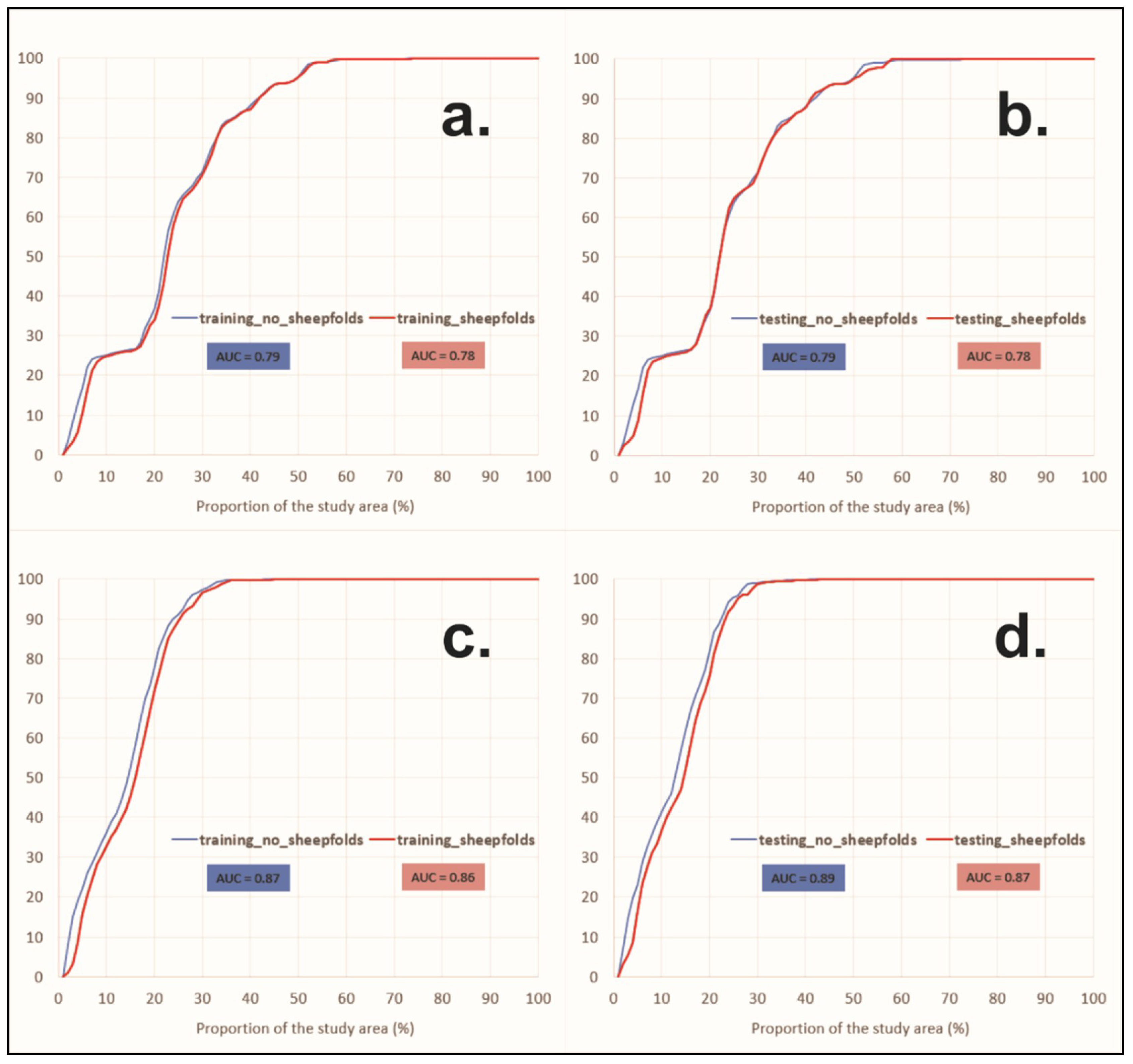
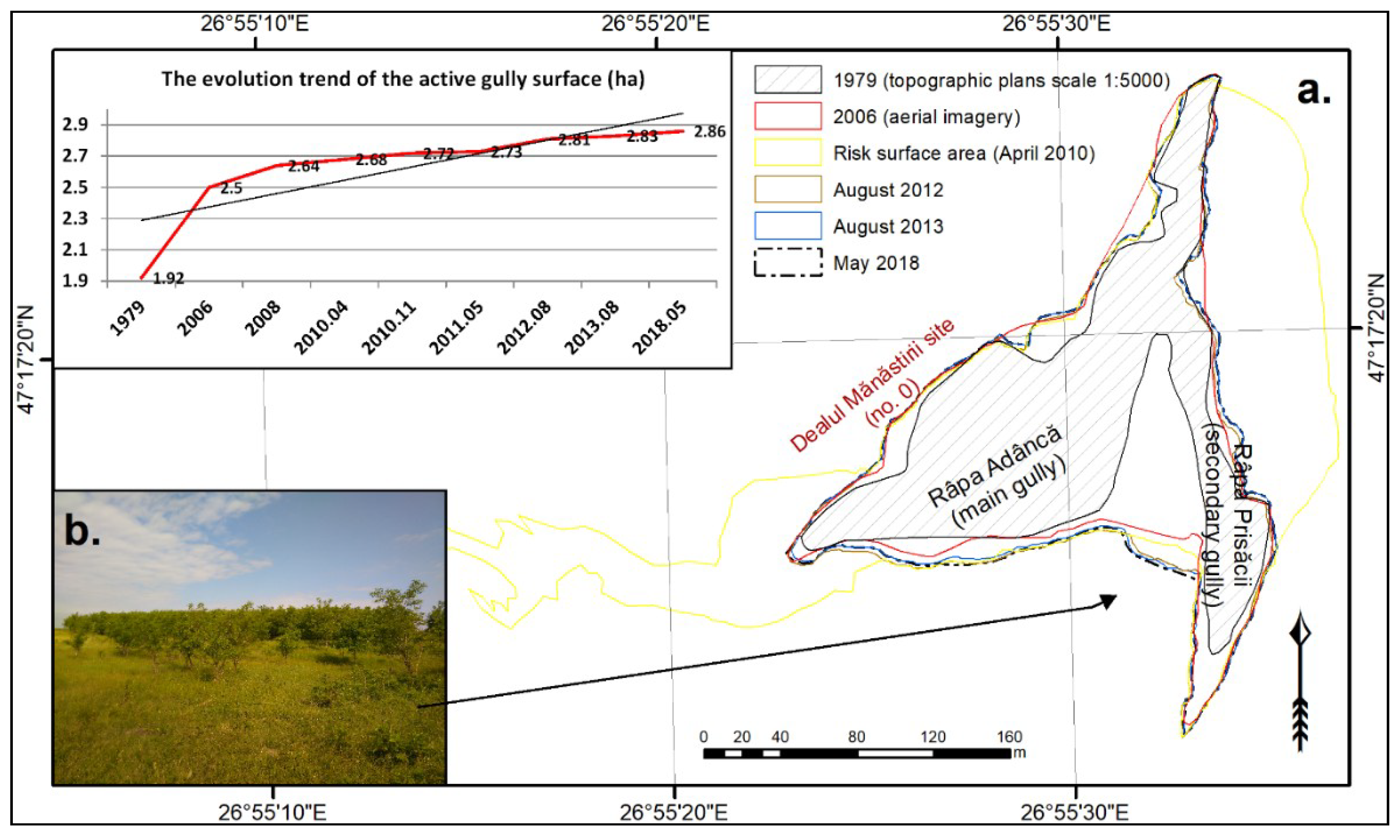
| Conditioning Factor | Class | No. of Pixels in Domain | Pixels % | Gully Pixels | Gully Pixels % | Statistical Index (SI) |
|---|---|---|---|---|---|---|
| Altitude (m) | 50–100 | 3,363,707 | 15.32 | 19,805 | 9.95 | −0.187 |
| 100–150 | 9,271,203 | 42.21 | 84,561 | 42.50 | 0.002 | |
| 150–200 | 5,048,669 | 22.98 | 58,594 | 29.45 | 0.107 | |
| 200–250 | 1,511,671 | 6.88 | 20,188 | 10.14 | 0.168 | |
| 250–300 | 1,263,479 | 5.75 | 11,039 | 5.54 | −0.015 | |
| 300–350 | 811,297 | 3.69 | 4590 | 2.35 | −0.204 | |
| 350–400 | 601,494 | 2.75 | 157 | 0.07 | −1.540 | |
| 400–440 | 89,623 | 0.42 | - | - | - | |
| Slope angle (degrees) | 0–3 | 8,873,175 | 40.40 | 39,638 | 19.92 | −0.307 |
| 3–7 | 6,894,280 | 31.39 | 81,943 | 41.19 | 0.117 | |
| 7–14 | 4,984,204 | 22.70 | 65,243 | 32.80 | 0.159 | |
| >14 | 1,209,484 | 5.51 | 12,110 | 6.09 | 0.043 | |
| Curvature | Concave | 385,283 | 1.75 | 11,463 | 5.76 | 0.516 |
| Flat | 21,045,116 | 95.83 | 183,289 | 92.14 | −0.017 | |
| Convex | 530,744 | 2.42 | 4182 | 2.10 | −0.060 | |
| Lithology | Sandstone | 4,484,871 | 20.42 | 29,775 | 14.97 | −0.134 |
| Limestone | 904,658 | 4.12 | 279 | 0.14 | −1.467 | |
| Clay, sand | 13,191,520 | 60.07 | 142,345 | 71.56 | 0.075 | |
| Clay | 3,380,094 | 15.39 | 26,535 | 13.33 | −0.062 | |
| Precipitations (mm/year) | 500–550 | 8,512,022 | 38.76 | 45,741 | 23 | −0.226 |
| 550–600 | 8,869,166 | 40.39 | 91,094 | 45.80 | 0.054 | |
| 600–650 | 2,375,521 | 10.82 | 47,193 | 23.7 | 0.341 | |
| 650–700 | 2,204,434 | 10.04 | 14,906 | 7.5 | −0.126 | |
| Distance from rivers (m) | 0–150 | 7,245,110 | 25.92 | 118,149 | 59.39 | 0.255 |
| 150–300 | 5,933,280 | 22.59 | 31,837 | 16 | −0.227 | |
| 300–450 | 4,009,197 | 17.99 | 17,461 | 8.78 | −0.318 | |
| 450–600 | 2,227,077 | 12.39 | 10,944 | 5.5 | −0.265 | |
| >600 | 2,546,479 | 8.37 | 20,453 | 10.33 | −0.050 | |
| Landforms | 1 | 13,718 | 0.06 | 408 | 0.2 | 0.516 |
| 2 | 195 | 0 | 1 | 0 | −0.247 | |
| 4 | 281,045 | 1.28 | 14,441 | 7.26 | 0.753 | |
| 5 | 11,409,495 | 51.95 | 59,176 | 29.75 | −0.242 | |
| 6 | 9,985,547 | 45.47 | 124,059 | 62.37 | 0.137 | |
| 7 | 260,802 | 1.19 | 791 | 0.40 | −0.475 | |
| 9 | 177 | 0 | 6 | 0 | 0.573 | |
| 10 | 10,164 | 0.05 | 52 | 0.02 | −0.248 | |
| Topographic wetness index (TWI) | −7–−2 | 568,058 | 2.59 | 3394 | 1.71 | −0.180 |
| −1–−0.1 | 44,494 | 0.20 | 588 | 0.30 | 0.164 | |
| 0–30 | 18,542,604 | 84.43 | 180,291 | 90.63 | 0.030 | |
| >30 | 2,805,987 | 12.78 | 14,661 | 7.36 | −0.238 | |
| Aspect | Flat | 3,463,117 | 15.77 | 36,987 | 18.60 | 0.071 |
| N | 3,664,609 | 16.69 | 45,583 | 22.92 | 0.137 | |
| NE | 3,457,392 | 15.74 | 21,850 | 10.99 | −0.156 | |
| E | 2,211,100 | 10.07 | 9741 | 4.90 | −0.313 | |
| SE | 2,237,844 | 10.19 | 6315 | 3.17 | −0.506 | |
| S | 2,259,101 | 10.29 | 5046 | 2.53 | −0.608 | |
| SW | 2,359,786 | 10.75 | 19,734 | 9.91 | −0.034 | |
| W | 1,201,188 | 5.47 | 21,126 | 10.62 | 0.288 | |
| NW | 1,107,006 | 5.04 | 32,552 | 16.36 | 0.511 | |
| Sheepfold density (/km2) | 0–0.3 | 12,855,513 | 58.53 | 111,078 | 55.83 | −0.020 |
| 0.3–0.92 | 5,580,961 | 25.41 | 50,123 | 25.20 | −0.003 | |
| 0.92–1.54 | 2,596,265 | 11.83 | 27,646 | 13.90 | 0.070 | |
| 1.54–3.01 | 928,404 | 4.23 | 10,087 | 5.07 | 0.078 | |
| Drainage density (km/km2) | <0.64 | 3,987,872 | 18.16 | 27,111 | 13.63 | −0.124 |
| 0.65–1.2 | 7,528,130 | 34.28 | 69,345 | 34.86 | 0.007 | |
| 1.3–1.8 | 7,518,991 | 34.24 | 78,858 | 39.64 | 0.063 | |
| 1.9–3.2 | 2,926,150 | 13.32 | 23,620 | 11.87 | −0.050 |
| Site No. | Site Name | Location (WGS84 Coordinates) | LMI Code/RAN Code | Susceptibility Class According to GSI (IV) | |
|---|---|---|---|---|---|
| N | E | ||||
| 3 | Dealul Mândra/la Iaz/Iazul 3 | 47°14′43″ | 27°08′7″ | IS-I-s-B-03527/95809.01 | Medium |
| 95 | Cantonul CFR nr. 38-39 | 47°12′46″ | 27°07′23″ | IS-I-s-B-03529/95809.03 | High |
| 18 | Dealul Mănăstirii/Chetrosul/sub Pădure | 47°15′25″ | 26°54′20″ | -/95578.01 | High |
| 24 | Dealul Mare Filiași/Dealul Boghiu | 47°15′12″ | 27°02′25″ | -/95827.01 | Medium |
| 36 | Valea Părului II | 47°17′47″ | 26°57′54″23 | IS-I-s-B-03519/95505.01 | Medium |
| 98 | Costești Cier/lângă Școală | 47°14′8.4″ | 26°55′39″ | IS-I-s-B-03560/95541.01 | Medium |
| 7 | Pietrăria din Valea Hainei | 47°12′50″ | 26°56′5″ | IS-I-s-B-03561/95541.02 | Medium |
| 55 | Costești/Podiș | 47°13′58″ | 26°57ʹ14″ | -/95541.04 | Medium |
| 37 | Tarlaua Grajd | 47°16ʹ36″ | 26°54′36″ | IS-I-s-B-03530/96691.01 | Medium |
| 1 | Dâmbul lui Pletosu | 47°18′10″ | 26°55′20″ | IS-I-s-B-03522/96682.03 | Very high |
| 49 | Dâmbul Morii | 47°14′45″ | 26°56′10″ | IS-I-s-A-03523/96682.04 | Very high |
| 99 | Cetățuia | 47°17′55″ | 26°54′50″ | IS-I-s-A-03521/96682.02 | Very high |
© 2018 by the author. Licensee MDPI, Basel, Switzerland. This article is an open access article distributed under the terms and conditions of the Creative Commons Attribution (CC BY) license (http://creativecommons.org/licenses/by/4.0/).
Share and Cite
Nicu, I.C. Is Overgrazing Really Influencing Soil Erosion? Water 2018, 10, 1077. https://doi.org/10.3390/w10081077
Nicu IC. Is Overgrazing Really Influencing Soil Erosion? Water. 2018; 10(8):1077. https://doi.org/10.3390/w10081077
Chicago/Turabian StyleNicu, Ionut Cristi. 2018. "Is Overgrazing Really Influencing Soil Erosion?" Water 10, no. 8: 1077. https://doi.org/10.3390/w10081077
APA StyleNicu, I. C. (2018). Is Overgrazing Really Influencing Soil Erosion? Water, 10(8), 1077. https://doi.org/10.3390/w10081077





